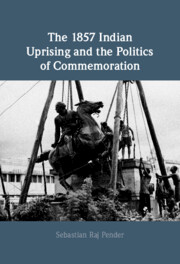Book contents
- The 1857 Indian Uprising and the Politics of Commemoration
- The 1857 Indian Uprising and the Politics of Commemoration
- Copyright page
- Dedication
- Contents
- Figures
- Acknowledgements
- Abbreviations
- Introduction
- 1 ‘Remember Cawnpore!’
- 2 ‘Forget Cawnpore!’
- 3 Negotiating Fear
- 4 The Mutiny of 1907
- 5 The War of Indian Independence
- 6 Remembering the Mutiny at the End of Empire: 1947–1972
- 7 Celebrating the First War of Independence Today
- Conclusion
- Bibliography
- Index
Introduction
Meaning, Memory, and Monument
Published online by Cambridge University Press: 21 April 2022
- The 1857 Indian Uprising and the Politics of Commemoration
- The 1857 Indian Uprising and the Politics of Commemoration
- Copyright page
- Dedication
- Contents
- Figures
- Acknowledgements
- Abbreviations
- Introduction
- 1 ‘Remember Cawnpore!’
- 2 ‘Forget Cawnpore!’
- 3 Negotiating Fear
- 4 The Mutiny of 1907
- 5 The War of Indian Independence
- 6 Remembering the Mutiny at the End of Empire: 1947–1972
- 7 Celebrating the First War of Independence Today
- Conclusion
- Bibliography
- Index
Summary
This introductory chapter situates the current study within the existing literature on the contested events of 1857 and highlights how a focus on the way in which the conflict became an almost obsessively commemorated event in colonial and postcolonial contexts can help us better understand a range of questions pertaining to identity, legitimacy, and power as successive generations (re)produced and (re)packaged the past for mass consumption in the constantly evolving present. In so doing, this chapter also outlines the methodological framework which will inform the study as a whole. Drawing on sociological accounts of ‘collective memory’, this chapter develops a socially grounded understanding of the relationship between memory and forgetting, and explains how practices of commemoration provide a moment in which this dynamic is played out.
- Type
- Chapter
- Information
- Publisher: Cambridge University PressPrint publication year: 2022

